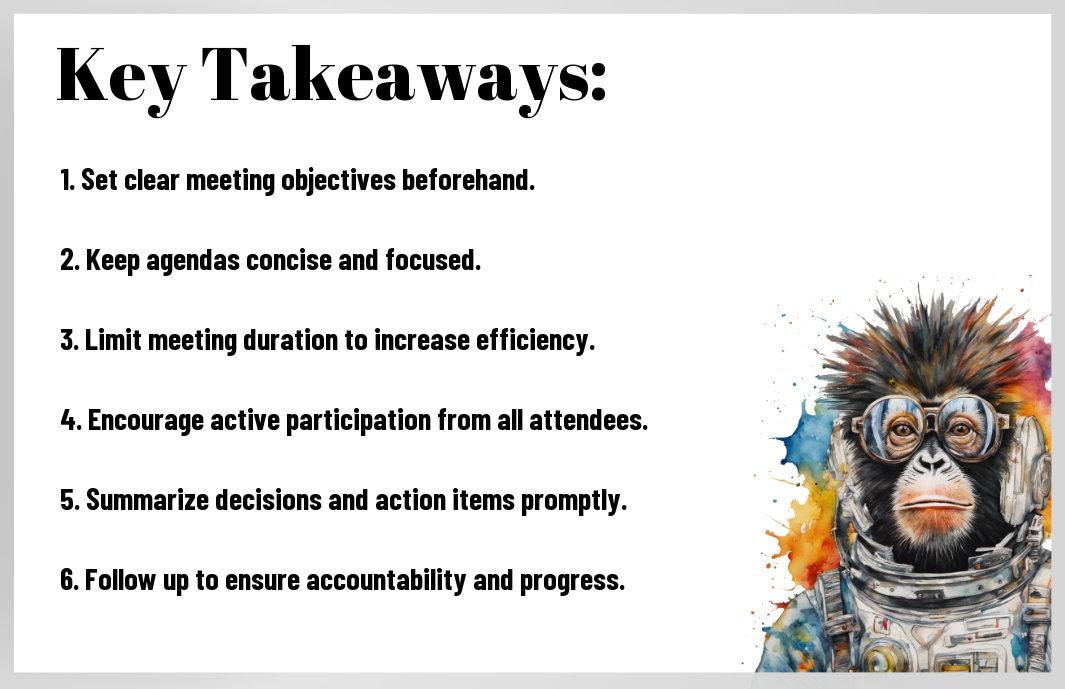You can transform your meeting culture by mastering the art of brevity. With efficient meeting strategies, you can save time and enhance productivity, keeping participants engaged and focused. Learning to limit meeting duration not only improves outcomes but also fosters a positive work environment where everyone feels valued. By adopting these practices, you can ensure that your meetings are productive and impactful, allowing you to allocate more time to critical tasks and empowering your team to achieve more with less.
Key Takeaways:
- Implement a clear agenda to keep meetings focused and efficient.
- Designate a timekeeper to ensure discussions stay on track and within the allotted time.
- Encourage active participation by inviting input from all attendees, fostering a collaborative environment.
The Importance of Effective Meetings
To achieve productivity and maintain focus, effective meetings are vital. They foster collaboration, enable decision-making, and ensure that every team member is aligned with common goals. When managed properly, these gatherings can optimize your time, encourage innovation, and elevate team morale. By prioritizing efficiency and purpose, you pave the way for a more engaged workforce ready to tackle organizational challenges.
Understanding Meeting Objectives
Effective meetings begin with clear objectives. Establishing what you aim to accomplish ensures that discussions stay on track and time is utilized wisely. By identifying specific outcomes, you empower participants to contribute meaningfully, leading to actionable decisions that drive progress and accountability within your team.
The Cost of Inefficiency
Before you underestimate the implications of poorly organized meetings, consider the impact on your team’s productivity.
For instance, a lack of focus and structure in meetings can lead to extended discussions that waste time and result in frustration among team members. This inefficiency not only diminishes morale but also contributes to increased operational costs. Each hour wasted translates into lost productivity that could have been better spent on value-generating activities. Ultimately, recognizing and addressing these inefficiencies is paramount for enhancing your team’s overall performance.

Strategies for Shortening Meetings
One of the best ways to shorten meetings is by implementing effective strategies that keep discussions focused and productive. By refining your meeting structure and ensuring that you adhere to established practices, you can foster a culture of efficiency that minimizes time loss and maximizes outcomes. Let’s explore some of these important strategies.
Setting Clear Agendas
Shortening meetings begins with establishing a clear agenda before the meeting takes place. Provide your team with a detailed outline of topics to be covered, including specific goals for each agenda item. This practice not only ensures that everyone comes prepared but also gives you a time frame to guide discussions, helping to keep conversations on track.
Time Management Techniques
For effective time management during meetings, it’s important that you allocate specific time slots for each agenda item. Implementing time constraints means you stay focused on the topics at hand and ensure discussions remain productive. Additionally, consider using a timer or appointing a timekeeper to help remind everyone when it’s time to move on. This encourages accountability and efficiency, ultimately leading to shorter, more productive meetings.
In fact, utilizing these time management techniques can profoundly enhance your meeting dynamics. By strictly adhering to time limits, you foster a disciplined environment where participants are less likely to meander off-topic. This not only reduces meeting duration but also increases participant engagement and motivation, as they see their time valued. Moreover, by tackling each agenda item efficiently, you can encourage a sense of accomplishment and drive momentum for further discussions.
Tools to Facilitate Efficient Meetings
Once again, effective meetings hinge on the right tools. Utilizing appropriate resources not only enhances collaboration but also streamlines the meeting process. From digital platforms for remote discussions to aids for keeping track of time, implementing these tools can significantly improve productivity. By adopting technology that empowers your team, you will find meetings becoming short and sweet, ultimately leading to better outcomes and increased engagement.
Digital Collaboration Tools
Tools such as Slack, Microsoft Teams, and Zoom provide platforms for streamlined communication and real-time collaboration. These technologies enable you to share ideas quickly, conduct virtual meetings, and stay connected with your team, no matter where you are. With powerful features like file sharing and integrated calendars, your meetings can focus on content delivery rather than logistics.
Timekeeping Aids
At the core of every productive meeting is effective time management. Utilizing timekeeping aids such as timers, clocks, or time management applications can significantly help you maintain focus and uphold the agenda. These tools provide the structure needed to ensure that discussions stay relevant and that every participant has the opportunity to contribute without dragging the meeting on longer than necessary.
With the use of timekeeping aids, not only can you allocate time to each agenda item, but you can also set reminders to keep discussions on track. Tools like Pomodoro timers or apps such as Time Timer allow you to visualize time passing, which helps you execute your agenda efficiently. By ensuring that meetings don’t extend beyond the requisite time, your team will appreciate the focused discussions, leading to higher productivity and improved morale.

Encouraging Participation and Engagement
After creating an agenda and establishing ground rules, it’s imperative to encourage participation and engagement throughout your meetings. Make an effort to recognize and invite input from all attendees, ensuring everyone feels valued. This will not only foster a collaborative atmosphere but also lead to more innovative ideas and solutions, transforming meetings into productive brainstorming sessions.
Inviting the Right People
About inviting the right people to your meetings, it’s important to select participants who have the necessary insights and responsibilities relevant to the agenda. This means considering stakeholders from various departments or teams to ensure diverse perspectives. By doing so, you not only enrich the discussion but also increase accountability and ownership over decision-making processes.
Promoting Open Communication
After you invite the right people, the next step is to promote open communication during meetings. Encourage every participant to express their thoughts and opinions openly, fostering an environment where all voices are heard equally.
Consequently, you may find that prioritizing open communication enhances trust and cooperation among team members. By regularly encouraging honest feedback and actively listening, you help create an atmosphere where individuals feel safe to share their ideas without fear of criticism. However, be vigilant about negative behaviors, such as interrupting or dismissing others, as these can significantly impact the collaboration climate and discourage participation. Aim for a balanced dialogue that not only builds rapport but also leads to effective decision-making.
Measuring Meeting Success
Unlike common belief, measuring the success of your meetings goes beyond just the completion of an agenda. It’s about evaluating whether the meeting objectives were achieved, the level of engagement, and if actionable outcomes were derived. To effectively gauge the value of your meetings, you must establish clear metrics that align with your goals, ensuring you’re utilizing time efficiently and productively.
Feedback Mechanisms
Against the traditional view of assessments, implementing feedback mechanisms can transform how you perceive meeting effectiveness. Solicit input from participants through anonymous surveys or direct discussions post-meeting. This allows you to understand their perspectives, improve engagement levels, and make necessary adjustments for future gatherings.
Analyzing Outcomes
Success in meetings lies in the details of the outcomes produced. After the meeting, take the time to review whether the goals set prior were met and what action items were assigned. The quality of decisions made, the clarity of tasks given, and the overall satisfaction of participants provide you with vital insights. By considering these factors, you can fine-tune your approach, minimize redundancies, and ensure that future meetings yield significant benefits. This process positions you to lead more effective discussions.’
Best Practices for Ongoing Improvement
Not only should you strive for efficiency in your meetings, but you must also focus on ongoing improvement. Continuously evaluating and refining your meeting strategies will yield better outcomes, ultimately enhancing collaboration and productivity within your team.
Regular Review of Meeting Culture
Among the best practices, regularly reviewing your meeting culture is vital for ensuring that your discussions remain relevant and effective. Gather feedback from participants and assess the effectiveness of your meetings to identify areas needing refinement.
Adaptation and Flexibility
With the ever-changing dynamics of the workplace, your meeting strategies must be flexible and adaptable. This ability to pivot allows you to cater to your team’s evolving needs and preferences.
To foster a culture of adaptability, be open to modifying your meeting formats, agendas, and frequencies based on participant feedback and the current context. Embrace experimentation by trying out new formats, such as stand-up meetings or workshops, to keep engagements fresh and engaging. Evaluate the impact of these changes regularly, as this will help you refine your approach and make your meetings more productive. By committing to continuous improvement, you set the stage for enhancing collaboration and achieving your team’s objectives.
To wrap up
On the whole, mastering your meetings with WorkWell can significantly enhance your productivity and keep your team engaged. By implementing strategies to streamline discussions and focus on vital topics, you can ensure that your meetings are not only efficient but also meaningful. This proactive approach allows you to foster a more collaborative work environment where time is effectively utilized, ultimately leading to improved outcomes for you and your colleagues. Embrace these techniques to transform your meetings into a powerful tool for success.
FAQ
Q: What is ‘WorkWell – Master Your Meetings – Make Them Short and Sweet’?
A: ‘WorkWell – Master Your Meetings – Make Them Short and Sweet’ is a productivity tool designed to streamline the meeting process. It provides strategies and techniques to help individuals and teams conduct meetings more efficiently and effectively, ensuring that discussions are focused, goals are clear, and time is managed wisely. By incorporating these practices, users can reduce the length of meetings while increasing their impact and engagement.
Q: How can ‘WorkWell’ help improve my team’s productivity during meetings?
A: ‘WorkWell’ offers a variety of tools and frameworks that encourage participants to prepare in advance, set clear agendas, and establish follow-up actions. The platform emphasizes the importance of limiting participant numbers and avoiding unnecessary discussions, which in turn helps to keep meetings concise. By utilizing these methods, teams can enhance focus, drive better outcomes, and ultimately decrease the amount of time spent in meetings.
Q: Are there any specific features included in ‘WorkWell’ that facilitate meeting organization?
A: Yes, ‘WorkWell’ includes several features designed to assist in organizing meetings effectively. These features include customizable agenda templates, time tracking tools, and participant feedback options. Additionally, it offers post-meeting follow-up reminders and action item tracking capabilities, ensuring that all participants are aligned on tasks and expectations. This comprehensive set of tools aids in creating a structured environment where meetings serve their intended purpose without unnecessary delays.

Leave a Reply